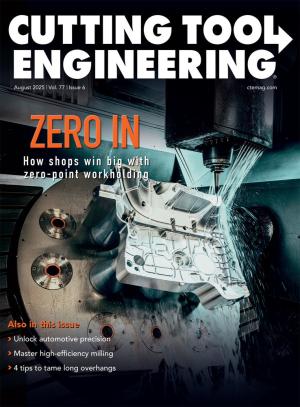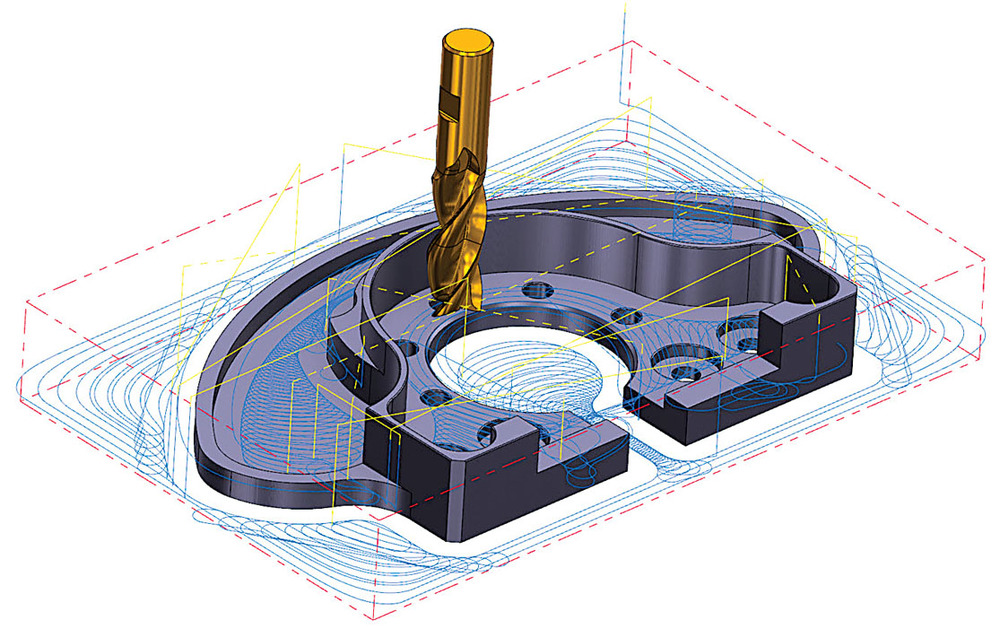 CAM software (above) guides the tool to create complex parts using HEM. Mastercam
CAM software (above) guides the tool to create complex parts using HEM. Mastercam
If a milling strategy comes along that promises critical advantages like higher productivity and longer tool life, it should be no surprise that shops would flock to it. And such has been the case with high-efficiency milling (HEM). Characterized by smaller radial depths of cut and larger axial depths of cut, HEM’s relatively light touch is also power-saving and machine-friendly. What’s more, HEM has become even more effective in recent years thanks to developments in areas such as tooling and software.
On the shop floor, one of the main aspects of HEM machinists appreciate is that “they’re not changing tools all the time,” noted Keith Carlile, national milling product manager at Iscar USA in Arlington, Texas.
HEM employs the full length of the tool, spreading heat and wear along the entire cutting edge. As a result, “it wouldn’t be out of the ordinary to see double, triple, even four times the tool life by implementing a high-efficiency strategy,” said Nathan Peynado, metalworking applications specialist at MSC Industrial Supply Co., which is dually headquartered in Melville, New York, and Davidson, North Carolina.
HEM tools also benefit from the special CAM-generated toolpaths — trochoidal, adaptive clearing and constant engagement, for example — that are employed when machining complex parts. These produce lower peak cutting forces than traditional roughing, which can cause high load spikes while cutting corners and curved features, noted Mike Gomez, principal R&D engineer at MSC Industrial Supply.
High metal removal rates
In addition, HEM offers high metal removal rates compared to conventional milling processes, in which wear is concentrated on a smaller tool area. Employing HEM, “you’re removing massive amounts of material, and you’re not destroying tools,” said Michael Stone, owner of Dynamic CNC USA LLC in Fort Lauderdale, Florida. Stone added that the technique allows the same endmills to be used for months. Providing contract machine programming and setup, Stone often visits shops with MSC’s Peynado. Together, the two can get a HEM process up and running and also optimize an existing process.
Thanks to high MRR, increases in productivity can be dramatic. When shops adopt HEM, “sometimes we see more than 50% increases in output,” said John Giraldo, engineering projects manager for the Americas at Sweden-headquartered Sandvik Coromant.
A lighter load
While giving a big boost to productivity, HEM can also reduce power consumption. With HEM doing lighter radial passes, high horsepower isn’t required, Carlile explained, noting that HEM is unlike “the old-fashioned way — get a big tool and take as big a cut as you possibly can — [that] requires a lot of torque and horsepower.”
A related bonus, he added, is that the technique is easy on machine tools, especially when more challenging materials are being cut. Benefits in this category include less stress on bearings and lower spindle loads.
As a result, Peynado said, HEM is accessible to shops that don’t have machines that are big and rigid enough for conventional milling of harder materials like exotic alloys and some stainless steels. “High-efficiency milling places so light a load on a machine that some of the more inferior machines are now capable” of cutting these materials, he noted.
In addition, Stone pointed out that HEM workholding doesn’t have to be as “crazy rigid” as would be rerequired to take big cuts in challenging materials.
Best HEM practices
To make a good thing even better, shops implementing HEM can benefit greatly by following the guidance of experts on the subject. For example, Gomez recommended that shops consult the tool recommendation applications or tool guides offered by tooling manufacturers. These suggest HEM-style strategies such as adaptive clearing and trochoidal milling alongside other process recommendations (feeds and speeds, depths of cut, etc.) for cutting different materials.
Also helpful are tool-related programs like that offered by MSC’s metalworking team, in which tools are tested to evaluate different cutting approaches before customers pay for the tools. After considering a particular HEM challenge, for example, Peynado will choose an MSC tool that he thinks will provide optimal results. Using this tool and the customer’s machine, he and Dynamic CNC’s Stone work together to test the tool and a machining strategy for the application. According to Peynado, the result could be an 80% reduction in the time required for a particular machining job.
In the area of process improvement, Giraldo pointed out that HEM generates a lot of chips that must be cleared out of the cutting zone to prevent recutting that could cause a tool to wear out prematurely. For effective chip evacuation and help with heat management, he recommends the use of high-pressure air blast or high-pressure coolant, depending on the material being cut.
Other keys to maximizing the success of a HEM process involve the machine tool used for the job. According to Gomez, an important decision in this area is whether to choose a horizontal or vertical machine tool. With a horizontal machine, a shop is working with gravity during machining, so chips are probably falling away from the part. Using a vertical machining center, however, chips are potentially falling back into the cutting zone, so there is a risk of recutting. “That’s not to say you can’t use a vertical machining center,” he said. “But when it comes to deploying this strategy successfully, things like that can play a big role.”
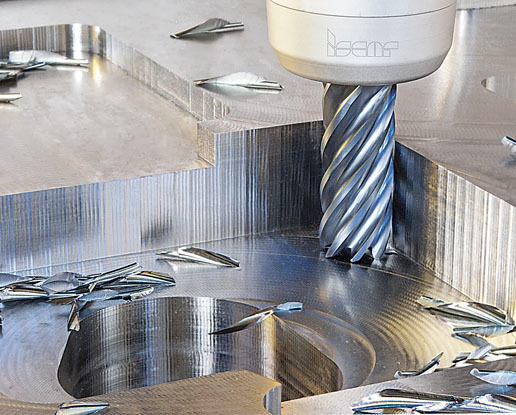 HEM users employ tools like this seven-flute endmill featuring variable helix and pitch for chatter-free high-speed trochoidal milling and finishing operations. Iscar USA
HEM users employ tools like this seven-flute endmill featuring variable helix and pitch for chatter-free high-speed trochoidal milling and finishing operations. Iscar USA
When a machine is tasked with a high-efficiency milling job, one thing to be aware of is that it might not be able to run as fast or move as quickly as you want it to, according to Carlile. If the computer program for a machining process says the operation should take 10 minutes, but the machine actually takes 20 minutes to complete it, the operation isn’t going to run correctly or well, he explained. So, if the computer-generated and actual cycle times don’t match, he urged shops to make changes in the programming so the operation lines up with what the machine is capable of doing.
Another thing to keep in mind is that HEM toolpaths like adaptive or trochoidal include very rapid changes in direction. “With some workhorse machine tools, when you try to run some of these complex paths, you can see the machine tool struggle to get up to speed,” Gomez said. If it can’t process code extremely quickly and doesn’t have sufficient “look-ahead” capabilities, he noted, the result will be jerky motion that can cause gouging, chatter and inconsistent surface finish.
This lines up with what Peynado once witnessed when he put a HEM program into an older machine. “It was pausing every step of the way, and the program wasn’t able to run efficiently,” he reported. “So, if you’re not running a newer machine, high-efficiency milling may not be an option for you.”
Even if a machine is up to the job of running a HEM program, that doesn’t guarantee a problem-free process. For one thing, “the machine is moving so fast, you can’t stop in time if something’s going wrong,” Stone noted. “So [things] are already broken before you know what happened.”
To catch process flaws before they cause costly mishaps, Peynado recommended simulating untried HEM routines using one of a number of different software products developed for that purpose.
When it comes to toolpath styles, shops that decide to employ HEM have many options, ranging from basic to advanced and produced using CAM software from many companies. Whatever CAM product a shop opts for, “make sure you’re trained up on your software,” advised David Miller, manager of product marketing engineering at Mastercam in Tolland, Connecticut. Mastercam’s Dynamic Motion toolpaths for HEM are part of the company’s standard course curriculum, which is available online and in classroom settings at all of Mastercam’s regional offices. To get even better acquainted with the Mastercam program’s style of motion and settings, Miller also recommended that users work with their local Mastercam representative and a tooling provider to do a test cut prior to the start of real machining.
Notable Developments
In addition to the long-recognized advantages of HEM, experts highlighted recent developments that are good for anyone employing the technique. Today, for example, Gomez reported that many high-end machine tools are equipped with advanced controllers that make use of sensors. With sensors on machine tools and smart toolholders, “now you’re able to measure forces or loads closer to your cutting tool so you can make adaptive changes in real time,” he noted. With this kind of force and vibration data, shops can refine HEM parameters to improve tool life and efficiency.
HEM has also become a more common choice for tackling the most challenging materials. “In the past, people thought of high-efficiency milling as something just for softer materials like aluminum and brass,” Peynado said. “But we’re starting to see it [used with] stainless steels, Inconels and exotic materials with great success.”
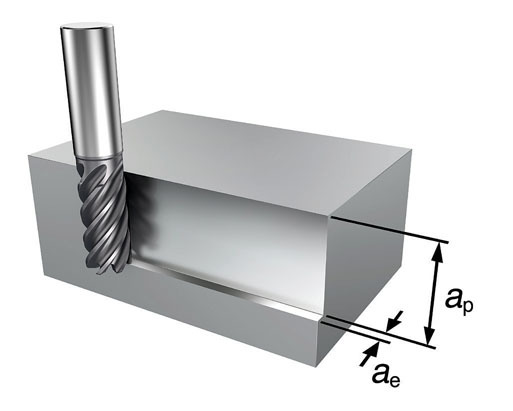 High-efficiency milling (HEM) is characterized by smaller radial depths of cut and larger axial depths of cut. Sandvik Coromant
High-efficiency milling (HEM) is characterized by smaller radial depths of cut and larger axial depths of cut. Sandvik Coromant
Moreover, Peynado has noticed that toolmakers are reacting to the growing popularity of HEM. “The high-efficiency milling strategy has been around in the industry for quite some time,” he said, “but now we’re starting to see a lot of tooling manufacturers catching up and creating tooling specifically for this application.”
According to Giraldo, toolmakers have changed overall endmill geometry to better suit HEM applications. As a result, he said, machinists skimming through Sandvik Coromant’s tool catalog will see the designation “high-feed side milling,” which indicates that a tool would normally be used for high-efficiency milling.
Distinguishing characteristics of HEM tools include unique edge prep and eccentric grinds around the relief face of the flutes to help with heat management, Gomez noted. In addition, HEM tools feature a variable pitch, variable helix cutting flute design. “Traditionally, endmills have had evenly spaced flutes. So, when they’re running at higher feed rates like you typically do with HEM, it’s easy to hit a resonant frequency that leads to chatter or unstable cutting,” Gomez said. Now, however, “you see a lot of newer tools with slightly offset flute spacing — that is, variable pitch.” As for variable helix, he explained that varying helical angles helps break up cutting forces into different frequencies, further reducing the risk of chatter.
Another key to the success of HEM tools is the grade optimization that toolmakers have undertaken. While an uncoated, off-the-shelf endmill might take 15 to 20 minutes to cut a feature in hard-to-machine materials like nickel-based alloys, the cycle time might be only five to seven minutes using an endmill coated with a grade optimized for those materials, Giraldo noted.
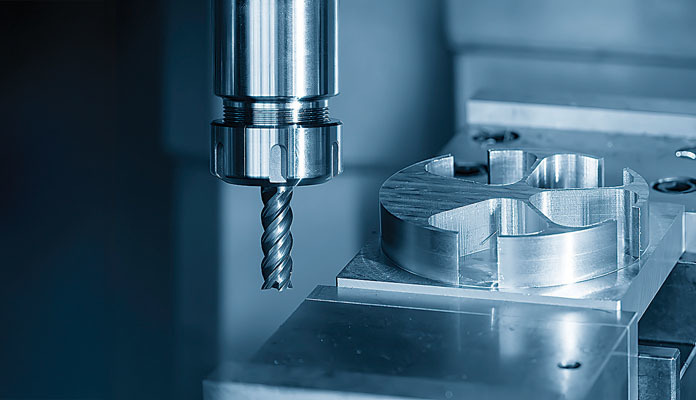 A trochoidal toolpath — a circular path with low radial depth of cut, coupled with simultaneous forward movement — is effective for creating deep slots and high-flank pockets while reducing load and wear on the tool. MSC Industrial Supply
A trochoidal toolpath — a circular path with low radial depth of cut, coupled with simultaneous forward movement — is effective for creating deep slots and high-flank pockets while reducing load and wear on the tool. MSC Industrial Supply
In recent years, HEM has also benefited from increased collaboration between CAM developers and tooling manufacturers. For example, Miller reported that Mastercam is constantly working with the R&D departments of many top tooling manufacturers. One result is the development of new and enhanced toolpaths aimed at getting the most out of new tool geometries.
In addition to tooling and software developments, Gomez pointed out that HEM has gotten a boost from the emergence of anti-vibration toolholders. “HEM is pretty vibration-friendly,” he said, “but being able to dissipate any vibration allows you to (run) your tool and machine tool a lot faster and take heavier cuts with HEM.”
Taken together, the inherent benefits of HEM and the advances that have improved the process seem to make a compelling case in its favor. Based on the results Stone has seen in his experiences with MSC’s Peynado, he’s surprised more machine shops aren’t HEM converts. “It’s made a huge difference in the shops that Nate (Peynado) and I work in,” he said. “Usually, the owners are blown away by how much we can decrease cycle times and also produce beautiful parts.”
Related Glossary Terms
- alloys
alloys
Substances having metallic properties and being composed of two or more chemical elements of which at least one is a metal.
- chatter
chatter
Condition of vibration involving the machine, workpiece and cutting tool. Once this condition arises, it is often self-sustaining until the problem is corrected. Chatter can be identified when lines or grooves appear at regular intervals in the workpiece. These lines or grooves are caused by the teeth of the cutter as they vibrate in and out of the workpiece and their spacing depends on the frequency of vibration.
- computer numerical control ( CNC)
computer numerical control ( CNC)
Microprocessor-based controller dedicated to a machine tool that permits the creation or modification of parts. Programmed numerical control activates the machine’s servos and spindle drives and controls the various machining operations. See DNC, direct numerical control; NC, numerical control.
- computer-aided manufacturing ( CAM)
computer-aided manufacturing ( CAM)
Use of computers to control machining and manufacturing processes.
- conventional milling ( up milling)
conventional milling ( up milling)
Cutter rotation is opposite that of the feed at the point of contact. Chips are cut at minimal thickness at the initial engagement of the cutter’s teeth with the workpiece and increase to a maximum thickness at the end of engagement. See climb milling.
- coolant
coolant
Fluid that reduces temperature buildup at the tool/workpiece interface during machining. Normally takes the form of a liquid such as soluble or chemical mixtures (semisynthetic, synthetic) but can be pressurized air or other gas. Because of water’s ability to absorb great quantities of heat, it is widely used as a coolant and vehicle for various cutting compounds, with the water-to-compound ratio varying with the machining task. See cutting fluid; semisynthetic cutting fluid; soluble-oil cutting fluid; synthetic cutting fluid.
- depth of cut
depth of cut
Distance between the bottom of the cut and the uncut surface of the workpiece, measured in a direction at right angles to the machined surface of the workpiece.
- endmill
endmill
Milling cutter held by its shank that cuts on its periphery and, if so configured, on its free end. Takes a variety of shapes (single- and double-end, roughing, ballnose and cup-end) and sizes (stub, medium, long and extra-long). Also comes with differing numbers of flutes.
- feed
feed
Rate of change of position of the tool as a whole, relative to the workpiece while cutting.
- flutes
flutes
Grooves and spaces in the body of a tool that permit chip removal from, and cutting-fluid application to, the point of cut.
- gang cutting ( milling)
gang cutting ( milling)
Machining with several cutters mounted on a single arbor, generally for simultaneous cutting.
- look-ahead
look-ahead
CNC feature that evaluates many data blocks ahead of the cutting tool’s location to adjust the machining parameters to prevent gouges. This occurs when the feed rate is too high to stop the cutting tool within the required distance, resulting in an overshoot of the tool’s projected path. Ideally, look-ahead should be dynamic, varying the distance and number of program blocks based on the part profile and the desired feed rate.
- machining center
machining center
CNC machine tool capable of drilling, reaming, tapping, milling and boring. Normally comes with an automatic toolchanger. See automatic toolchanger.
- metalworking
metalworking
Any manufacturing process in which metal is processed or machined such that the workpiece is given a new shape. Broadly defined, the term includes processes such as design and layout, heat-treating, material handling and inspection.
- milling
milling
Machining operation in which metal or other material is removed by applying power to a rotating cutter. In vertical milling, the cutting tool is mounted vertically on the spindle. In horizontal milling, the cutting tool is mounted horizontally, either directly on the spindle or on an arbor. Horizontal milling is further broken down into conventional milling, where the cutter rotates opposite the direction of feed, or “up” into the workpiece; and climb milling, where the cutter rotates in the direction of feed, or “down” into the workpiece. Milling operations include plane or surface milling, endmilling, facemilling, angle milling, form milling and profiling.
- pitch
pitch
1. On a saw blade, the number of teeth per inch. 2. In threading, the number of threads per inch.
- relief
relief
Space provided behind the cutting edges to prevent rubbing. Sometimes called primary relief. Secondary relief provides additional space behind primary relief. Relief on end teeth is axial relief; relief on side teeth is peripheral relief.
- stainless steels
stainless steels
Stainless steels possess high strength, heat resistance, excellent workability and erosion resistance. Four general classes have been developed to cover a range of mechanical and physical properties for particular applications. The four classes are: the austenitic types of the chromium-nickel-manganese 200 series and the chromium-nickel 300 series; the martensitic types of the chromium, hardenable 400 series; the chromium, nonhardenable 400-series ferritic types; and the precipitation-hardening type of chromium-nickel alloys with additional elements that are hardenable by solution treating and aging.
- toolpath( cutter path)
toolpath( cutter path)
2-D or 3-D path generated by program code or a CAM system and followed by tool when machining a part.

